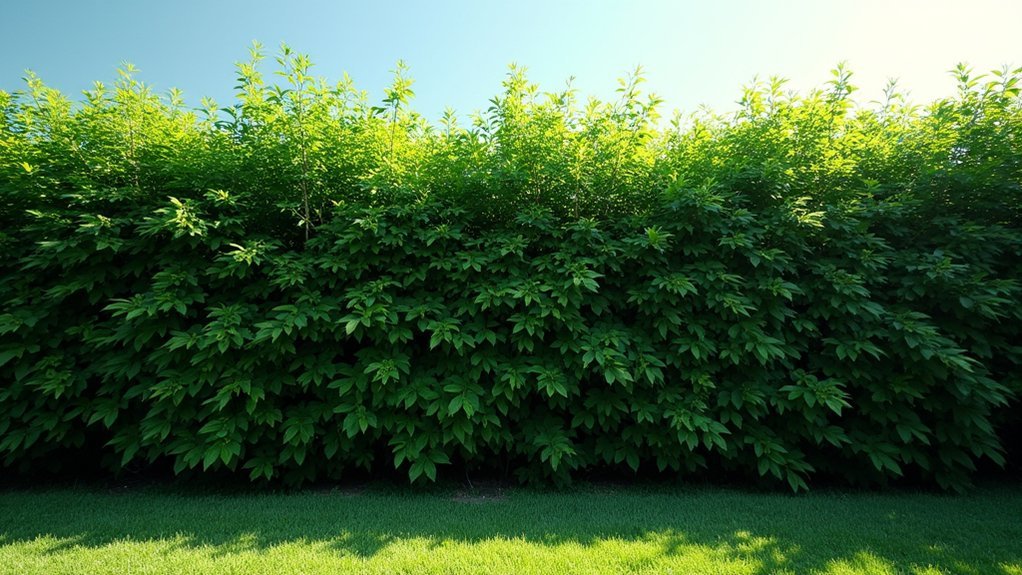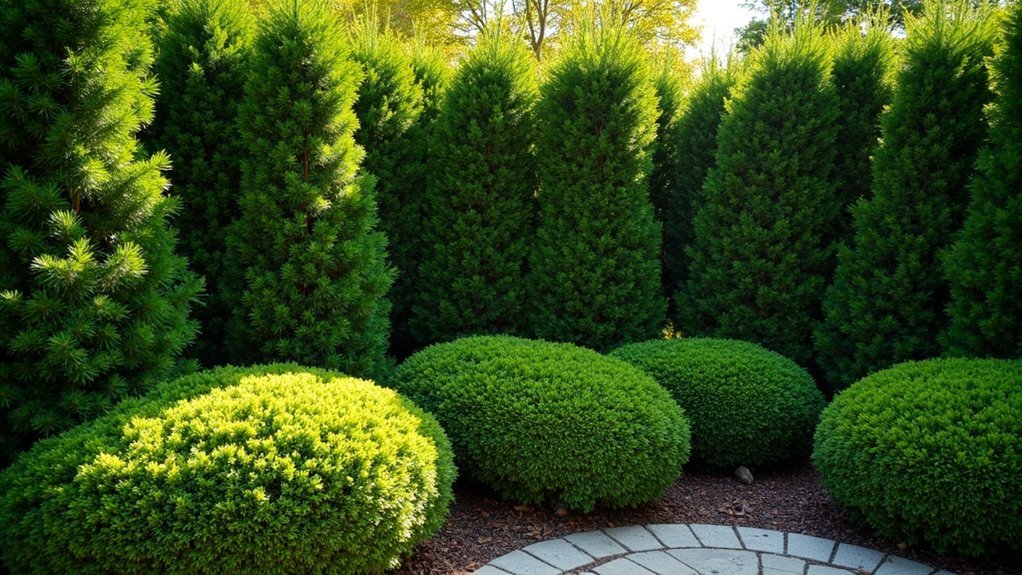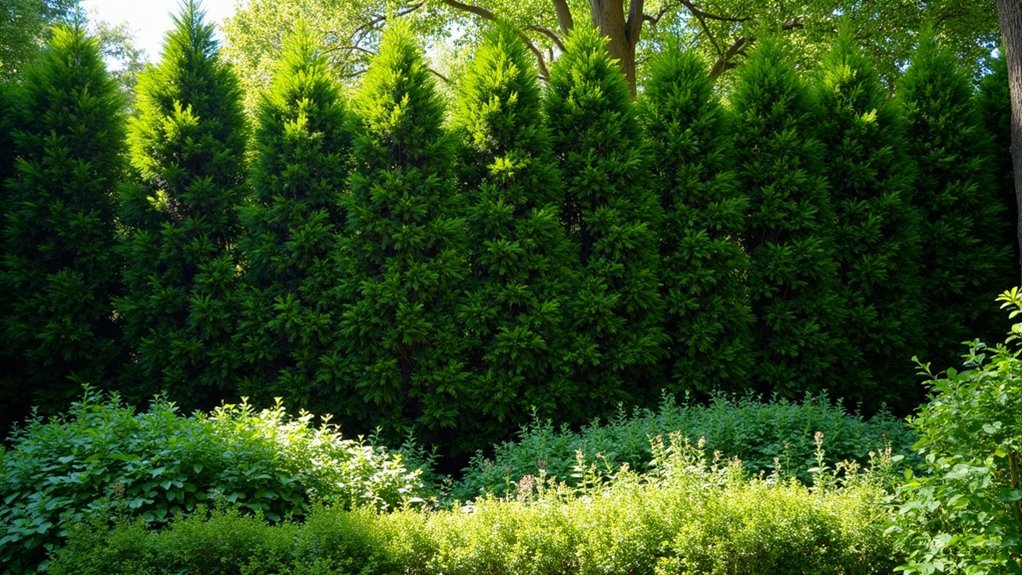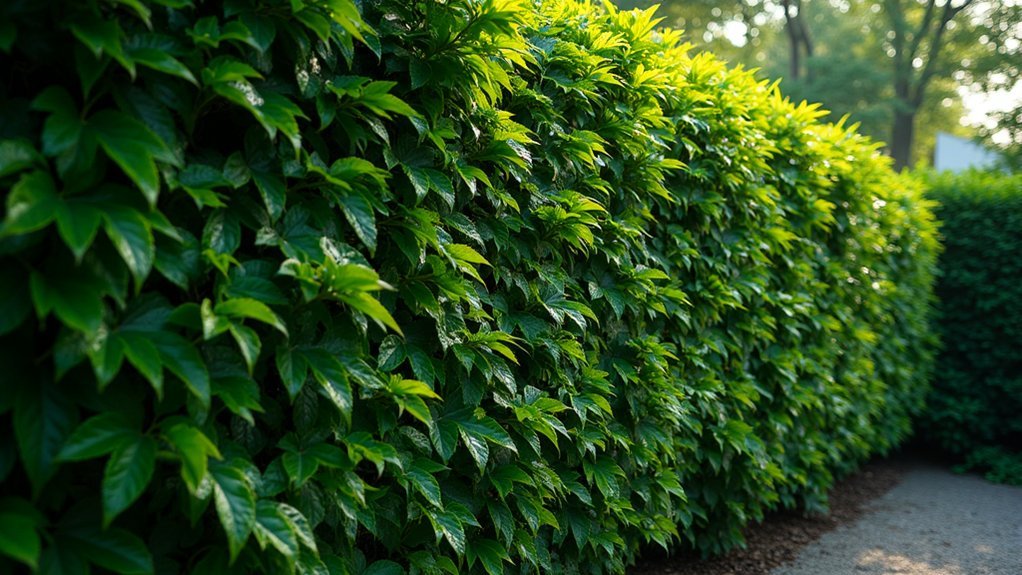Dense shrubs offer natural privacy screens with multiple benefits beyond basic seclusion. You’ll enjoy noise reduction, wildlife habitat creation, and year-round coverage with evergreen varieties like Arborvitae or Skip Laurel. Unlike traditional fences, these living barriers purify air, prevent soil erosion, and require less maintenance while providing aesthetic appeal through varied heights and textures. A strategically layered planting approach eliminates gaps while supporting local ecosystems. Discover how this sustainable solution transforms your outdoor space into a secluded sanctuary.
10 Second-Level Headings for “Why Choose Dense Shrubs for Privacy Screens?”

When planning your outdoor sanctuary, dense shrubs offer compelling advantages for creating effective privacy screens.
You’ll benefit from their natural noise-reducing properties, especially valuable if you live in a busy urban area. The dense foliage effectively blocks unsightly views while establishing clear boundaries between your property and neighboring spaces.
Dense shrubs naturally buffer urban noise while creating defined boundaries and concealing undesirable views from neighboring properties.
Choose evergreen hedge varieties for year-round privacy screening, eliminating seasonal gaps in your secluded retreat.
Many dense shrubs also support local wildlife, bringing birds and beneficial insects to your garden while creating natural privacy barriers.
Consider planting in layers with varying heights and textures for a more aesthetically pleasing privacy screen.
This approach not only maximizes seclusion but creates visual interest throughout your landscape, turning a functional privacy solution into a beautiful garden feature.
The Environmental Benefits of Living Privacy Barriers
Unlike artificial barriers, dense shrubs deliver remarkable environmental benefits while providing privacy for your outdoor spaces. Your privacy hedge acts as a natural ecosystem supporter, offering multiple advantages beyond simple screening.
When you plant a dense screen, you’re creating:
- Wildlife habitat that supports songbirds, pollinators, and beneficial insects
- Natural air purifiers that absorb carbon dioxide and release oxygen
- Sound buffers that reduce noise pollution through thick foliage
- Climate regulators that provide cooling shade and reduce energy consumption
Your privacy hedge also contributes to soil conservation by preventing erosion and retaining moisture.
Top Dense Evergreen Shrubs for Year-Round Seclusion

Creating a visual barrier that works in all seasons is possible with the right selection of dense evergreen shrubs.
You’ll find options like Emerald Green Arborvitae and Green Giant Arborvitae that provide thick, year-round coverage while supporting local wildlife with shelter and food sources.
These living screens not only offer superior privacy compared to fencing but also create habitat for birds and beneficial insects that’ll enhance your garden’s ecological value.
Density for Visual Barriers
Privacy seekers can block out prying eyes with several standout evergreen shrubs that create impenetrable visual barriers.
The density of these evergreen options guarantees complete seclusion while enhancing your landscape’s beauty.
When selecting shrubs for maximum privacy, consider these dense options:
- Emerald Green Arborvitae – Grows up to 15 feet tall with thick, year-round foliage that creates an effective natural wall.
- Green Giant Arborvitae – Reaches impressive heights of 20-30 feet quickly, perfect for screening large areas.
- Leyland Cypress – Forms a substantial pyramidal barrier up to 30 feet tall and 20 feet wide.
- Skip Laurel – Combines privacy with beauty through its glossy leaves and fragrant spring flowers.
Privet offers another excellent choice, maintaining its dense screening properties throughout the year with regular pruning.
Year-Round Privacy Solutions
While seasons change throughout the year, your need for privacy remains constant, making evergreen shrubs the gold standard for continuous seclusion.
Emerald Green Arborvitae creates privacy with its dense evergreen foliage that grows up to 15 feet tall, ensuring your space remains sheltered regardless of season.
For year-round privacy with minimal maintenance, consider Skip Laurel’s glossy dark green leaves that provide consistent screening at heights of 12-15 feet.
If you’re seeking rapid results, Green Giant Arborvitae quickly reaches 20-30 feet, while Leyland Cypress offers similar heights with a lush pyramidal form ideal for sunny locations.
In smaller spaces, Bright N Tight™ Carolina Laurel delivers effective seclusion at just 10 feet tall, thriving in various light conditions while maintaining a neat, dense profile all year.
Wildlife-Supporting Greenery
Beyond their visual screening capabilities, the best privacy shrubs serve double duty as vibrant wildlife habitats.
By incorporating dense evergreen shrubs like Green Giant Arborvitae and Leyland Cypress into your landscape, you’re creating a sanctuary that benefits both you and the local ecosystem.
Your privacy screen becomes a thriving wildlife haven when you choose the right plants.
Consider these wildlife-supporting options:
- Green Giant Arborvitae – Reaches 20-30 feet tall, providing shelter for birds while creating an effective noise barrier
- Leyland Cypress – Attracts birds with its pyramidal form and dense foliage
- Emerald Green Arborvitae – Offers nesting sites with its bright, compact growth
- Skip Laurel – Contributes to biodiversity while maintaining year-round screening
You’ll enjoy both seclusion and the satisfaction of supporting local wildlife with these multifunctional evergreen choices.
Layering Techniques for Maximum Visual Screening

Create maximum privacy in your garden by planting shrubs in a staggered pattern rather than straight lines, which eliminates gaps and creates a fuller barrier.
You’ll achieve thorough screening by incorporating plants of varying heights—tall backdrop shrubs, mid-height fillers, and lower foreground species—that work together to block sightlines at every level.
Combining deciduous and evergreen varieties guarantees your privacy screen maintains ideal density throughout the seasonal changes, with each plant type compensating for the others during their less-dense periods.
Staggered Planting Patterns
When planning a privacy screen with dense shrubs, staggered planting patterns offer superior coverage compared to traditional single-row designs.
By combining evergreen and deciduous species in tiered arrangements, you’ll create a dense, natural-looking barrier that provides year-round privacy.
This layering technique maximizes your screening potential in four key ways:
- Depth perception – Taller plants at the back with progressively shorter ones in front create visual interest.
- Gap prevention – Overlapping plants eliminate sightlines through your privacy screen.
- Disease resistance – Diverse plant selections reduce vulnerability to species-specific pests.
- Weed suppression – Lower-level groundcovers and ornamental grasses fill in spaces between larger shrubs.
You’ll find your staggered privacy screen not only functions better but also creates a more aesthetically pleasing landscape feature with varied textures and seasonal interest.
Multiple Height Levels
Building upon the staggered planting concept, multiple height levels form the backbone of truly effective privacy screens. When you create a layered hedge with taller shrubs at the back, medium varieties in the middle, and low groundcovers in front, you’ll achieve extensive visual screening that works year-round.
This strategic layering doesn’t just look appealing—it’s functional too. Your multiple height levels will maintain privacy even as seasons change, with different plants providing coverage when others might be dormant.
The layered approach also improves your screen’s overall health by enhancing airflow and light penetration while reducing pest vulnerability.
For maximum effectiveness, carefully space each layer and select compatible plants. You’ll be rewarded with a dense, living wall that blocks unwanted views and absorbs neighborhood noise, creating your own peaceful sanctuary.
Seasonal Foliage Density
Maintaining consistent privacy throughout the year demands thoughtful consideration of seasonal foliage density. By strategically combining deciduous shrubs with evergreen shrub varieties, you’ll create a screen that remains effective regardless of season.
This mixing technique guarantees your privacy barrier maintains its functionality while adding visual interest to your landscape.
For maximum seasonal foliage density, consider these essential strategies:
- Position taller evergreens at the back of your planting area to provide year-round structure.
- Integrate deciduous shrubs with interesting branch patterns for winter interest.
- Plant faster-growing varieties between slower specimens for quicker initial coverage.
- Add ornamental grasses around the perimeter to fill lower gaps.
Remember to space plants slightly closer than typically recommended when privacy is your primary goal—just avoid overcrowding that might compromise plant health.
Sound Absorption Properties of Thick Foliage Plants

Beyond their visual screening capabilities, dense shrubs offer remarkable sound absorption benefits for homeowners seeking tranquility. When you plant thick shrubs around your property, you’re creating a natural sound barrier that can reduce noise pollution by up to 10 decibels in residential areas.
The dense foliage works by scattering and absorbing sound waves through their leaves and branches. For maximum sound absorption, combine evergreen and deciduous shrubs to maintain noise reduction year-round, regardless of seasonal changes.
The structural diversity of various shrub types enhances this effect, as different foliage arrangements provide more surface area for sound waves to interact with.
If you’re dealing with urban traffic, construction noise, or noisy neighbors, a well-planned hedge will greatly dampen these disturbances, creating a quieter outdoor sanctuary.
Seasonal Considerations for Privacy Screen Plantings
When planning your privacy screen, you’ll need to choose between evergreens that maintain coverage year-round and deciduous shrubs that offer stunning fall color before dropping their leaves.
Your winter protection strategy should include at least 60% evergreen varieties to guarantee adequate screening during the coldest months when privacy is still desired.
Consider layering both types strategically, placing evergreens as the backbone with deciduous shrubs interspersed to create visual interest through seasonal changes.
Winter Protection Strategies
Although privacy screens provide year-round seclusion, they face unique challenges during the winter months that require special attention. Dense shrubs can serve as excellent windbreaks, protecting more delicate plants in your landscape from harsh winter conditions.
For ideal winter protection of your privacy screen, consider these strategies:
- Choose evergreen varieties for winter planting to maintain continuous coverage when deciduous plants lose their foliage.
- Apply a thick layer of mulch around the base of shrubs to regulate soil moisture and temperature.
- Install temporary windbreaks or snow fences to shield young shrubs from heavy snow and ice damage.
- Monitor soil moisture regularly, adjusting your watering schedule to prevent both dehydration and oversaturation.
These protective measures will help guarantee your dense shrubs remain healthy through winter, maintaining their privacy function year-round.
Deciduous vs. Evergreen Options
Winter protection strategies naturally lead us to contemplate the fundamental choice between deciduous and evergreen shrubs for your privacy screen. When selecting plants, consider how their seasonal behaviors will affect your privacy needs throughout the year.
| Feature | Evergreen Shrubs | Deciduous Shrubs |
|---|---|---|
| Winter Privacy | Full coverage | Reduced screening |
| Growth Rate | Moderate to fast | Variable |
| Seasonal Interest | Consistent green | Flowers and fall color |
| Height Potential | Up to 12-15 feet | Varies by species |
| Maintenance | Less seasonal cleanup | Fall leaf management |
You’ll find evergreen shrubs provide constant privacy year-round, making them ideal for permanent screening solutions. In contrast, deciduous shrubs offer spectacular seasonal changes but compromise winter privacy. Consider combining both types for a layered privacy screen that delivers year-round functionality with the added bonus of seasonal visual interest.
Native Dense Shrubs That Support Local Ecosystems

Beyond simply creating privacy, native dense shrubs serve as vital components in your local ecosystem’s health and sustainability. When you choose species like Inkberry or American Elderberry for your privacy screen, you’re creating wildlife havens that support biodiversity while meeting your landscaping needs.
Native dense shrubs offer remarkable advantages:
- They’re naturally adapted to local soil and climate, requiring less water and maintenance.
- They provide significant food sources and shelter for pollinators and birds.
- They create effective barriers against wind and noise pollution.
- They help combat invasive species by promoting balanced ecosystems.
Comparing Maintenance Requirements: Shrubs vs. Traditional Fences
While many homeowners initially gravitate toward traditional fencing for privacy, dense shrubs offer compelling long-term maintenance advantages that deserve serious consideration.
Unlike wooden fences that require regular painting, staining, and repairs, a privacy screen created from dense shrubs needs only occasional pruning and fertilizing. You’ll save markedly over time, as fences typically need replacement every 10-20 years, while well-established shrubs can thrive for decades.
Your dense shrubs will naturally adapt to local conditions, becoming more self-sufficient and requiring fewer resources once established. They’ll also contribute positively to your local ecosystem, providing habitat for beneficial wildlife—something no fence can offer.
Best of all, you’re not limited by standard fence heights or designs. Your living privacy screen can be customized with various species to create exactly the look and privacy level you desire.
Creating Microclimates With Strategic Shrub Placement
Strategic placement of dense shrubs transforms your landscape into a series of beneficial microclimates that extend well beyond simple privacy concerns.
Your privacy screen can simultaneously regulate temperature and moisture levels by providing shade and reducing wind exposure.
When you position dense shrubs thoughtfully, you’ll create:
- Sheltered environments that support diverse plant communities
- Natural barriers that filter dust and reduce noise pollution
- Protected spaces that retain soil moisture and nutrients
- Insulated areas that lower your home’s energy costs
Design Principles for Aesthetically Pleasing Privacy Screens
The most effective privacy screens balance functionality with visual appeal, transforming utilitarian barriers into landscape focal points.
When designing with dense shrubs, consider layering various heights and textures to create visual depth. You’ll achieve maximum impact by staggering your plantings rather than placing them in straight lines—this improves air circulation while maintaining privacy.
For year-round interest, combine evergreen and deciduous dense shrubs that offer seasonal changes in color and texture.
Don’t overcrowd your privacy screen; proper spacing allows each plant to develop its full potential and creates a more organized appearance.
Whenever possible, incorporate native species into your design principles. They’ll not only thrive with less maintenance but also support local wildlife, adding ecological value to your aesthetically pleasing boundary.
Frequently Asked Questions
What Shrubs Are Good for Privacy Screens?
You’ll find several excellent privacy shrubs: Emerald Green Arborvitae (12-15ft tall), Green Giant Arborvitae (20-30ft), Skip Laurel (12-15ft with flowers), Leyland Cypress (20-30ft), and adaptable Privet that attracts wildlife.
What Is the Most Dense Privacy Hedge?
The Emerald Green Arborvitae offers the most dense privacy hedge. You’ll love its tight, bright green foliage that creates an excellent visual barrier while maintaining a compact 4-5 foot width as it grows.
What Is the Best Shrub for Screening?
The best shrub for screening is Green Giant Arborvitae. You’ll love its fast growth rate, dense evergreen foliage, and impressive height of up to 30 feet. It’s low-maintenance and creates an effective natural barrier.
What Is the Best Bush to Grow for Privacy?
For the best privacy bush, you’ll love Emerald Green Arborvitae. It’s dense, grows 12-15 feet tall, and creates an effective screen with thick foliage. Green Giant Arborvitae works well for larger properties.
In Summary
When you invest in dense shrubs for privacy screens, you’re choosing a living solution that offers beauty, sustainability, and functionality. They’ll enhance your property value while creating your own personal sanctuary. Whether you’ve selected evergreens for year-round coverage or native species for ecological benefits, your shrub barrier will provide the perfect blend of seclusion and natural charm for years to come.





Leave a Reply